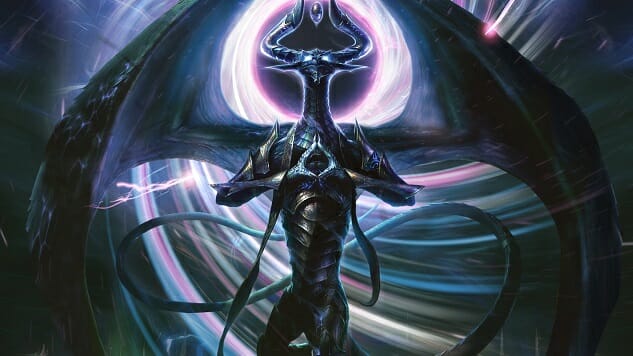Magic‘s The War of the Spark Is an All-Star Planeswalker Jam
Images courtesy of Wizards of the Coast
War of the Spark, the newest set that’s out now for Magic: The Gathering, is a capstone for the past couple years of the game. 2015’s Magic Origins reconfigured some key characters from the game’s story, 2016’s Oath of the Gatewatch unified them into a superteam of multiverse-spanning wizard warriors, and now War of the Spark is putting them up against their biggest bad guy: the nefarious dragon Nicol Bolas. Narratively, it’s a big culminating moment, but the vast majority of most people’s time around Magic doesn’t have much to do with that splashy story. It has to do with physical and digital cards. War of the Spark tries to be as epic mechanically as it is narratively, and that’s where it stumbles for me.
The big pitch behind War of the Spark is that an evil, magical dragon has invaded Ravnica, one of the most popular planes (worlds) of Magic. He’s brought a zombie army, his own lackeys, and he’s activated a trap that will bring all of the planeswalkers (powerful wizard warriors) to the plane for one final battle. That shakes out in a very specific way in the design of this set versus others: there’s a planeswalker card in every pack.
A planeswalker in Magic is normally a special thing. There are generally less than five printed in each set of 260 cards or so, and if a player can cast a planeswalker and keep it in the game, they can generally win. That’s because planeswalkers are sort of pseudo-players in that they sit on the board, have an ability you can activate without paying any resources every turn, and generally have an “ultimate” ability that secures a game win. For example, if an opponent doesn’t interact with her, an unattended Liliana of the Veil will make them discard a card a turn until she makes them destroy half of their board. It’s brutal.
But since War of the Spark is centered on a war that is drawing many planeswalkers to one place, they’re everywhere. Instead of there being a few of them, there are 36 in the set, and they appear at the uncommon rarity on up. When you open up packs to play a Limited format, you will see a lot of them. When you go to build decks in Constructed, you will have a lot to choose from. A card type that was fairly rare and didn’t come up in deckbuilding considerations or combat math all that often is now a massive, integral part of the game in both formats.
The introduction of a mass number of planeswalkers to the Limited formats means that the game is more complex in two ways.
-

-

-

-

-

-

-

-

-

-

-

-

-

-

-

-

-

-

-

-

-

-

-

-

-

-

-

-

-

-

-

-

-

-

-

-

-

-

-

-








































